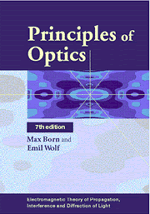Book contents
- Frontmatter
- Preface to corrected reprint of the seventh edition
- Preface to the first edition
- Preface to the second edition
- Preface to the third edition
- Preface to the fourth edition
- Preface to the fifth edition
- Preface to the sixth edition
- Preface to the seventh edition
- Contents
- Historical introduction
- I Basic properties of the electromagnetic field
- II Electromagnetic potentials and polarization
- III Foundations of geometrical optics
- IV Geometrical theory of optical imaging
- V Geometrical theory of aberrations
- VI Image-forming instruments
- VII Elements of the theory of interference and interferometers
- VIII Elements of the theory of diffraction
- IX The diffraction theory of aberrations
- X Interference and diffraction with partially coherent light
- XI Rigorous diffraction theory
- XII Diffraction of light by ultrasonic waves
- XIII Scattering from inhomogeneous media
- XIV Optics of metals
- XV Optics of crystals
- Appendices
- Author index
- Subject index
XIV - Optics of metals
- Frontmatter
- Preface to corrected reprint of the seventh edition
- Preface to the first edition
- Preface to the second edition
- Preface to the third edition
- Preface to the fourth edition
- Preface to the fifth edition
- Preface to the sixth edition
- Preface to the seventh edition
- Contents
- Historical introduction
- I Basic properties of the electromagnetic field
- II Electromagnetic potentials and polarization
- III Foundations of geometrical optics
- IV Geometrical theory of optical imaging
- V Geometrical theory of aberrations
- VI Image-forming instruments
- VII Elements of the theory of interference and interferometers
- VIII Elements of the theory of diffraction
- IX The diffraction theory of aberrations
- X Interference and diffraction with partially coherent light
- XI Rigorous diffraction theory
- XII Diffraction of light by ultrasonic waves
- XIII Scattering from inhomogeneous media
- XIV Optics of metals
- XV Optics of crystals
- Appendices
- Author index
- Subject index
Summary
So far we have been concerned with the propagation of light in nonconducting, isotropic media. We now turn our attention to the optics of conducting media, more particularly to metals. An ordinary piece of metal is a crystalline aggregate, consisting of small crystals of random orientation. Single crystals of appreciable size are rare, but can be produced artificially; their optical properties will be studied in Chapter XV. A mixture of randomly oriented crystallites behaves evidently as an isotropic substance, and as the theory of light propagation in a conducting isotropic medium is much simpler than in a crystal, we shall consider it here in some detail.
According to §1.1, conductivity is connected with the appearance of Joule heat. This is an irreversible phenomenon, in which the electromagnetic energy is destroyed, or more precisely transformed into heat, and in consequence an electromagnetic wave in a conductor is attenuated. In metals, on account of their very high conductivity, this effect is so large that they are practically opaque. In spite of this, metals play an important part in optics. Strong absorption is accompanied by high reflectivity, so that metallic surfaces act as excellent mirrors. Because of the partial penetration of light into a metal, it is possible to obtain information about the absorption constants and the mechanism of absorption from observations of the reflected light, even though the depth of penetration is small.
- Type
- Chapter
- Information
- Principles of OpticsElectromagnetic Theory of Propagation, Interference and Diffraction of Light, pp. 735 - 789Publisher: Cambridge University PressPrint publication year: 1999
- 5
- Cited by



